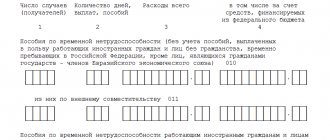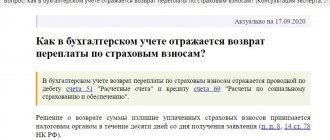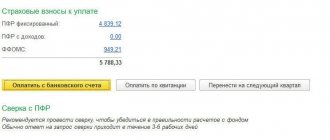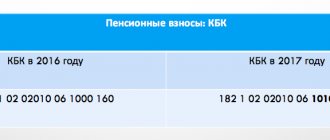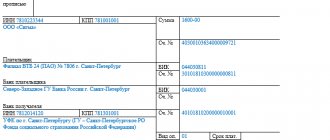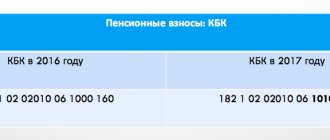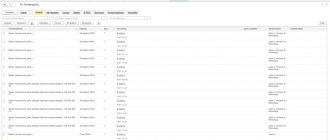Svetlana
Hello.
Please tell me in this situation. I am an individual entrepreneur using the simplified tax system (15%) without hiring. I pay quarterly fixed contributions myself to the Pension Fund and the Federal Compulsory Medical Insurance Fund through the cash desk of Sberbank, since there is no current account or cash desk. But I want to run 1C 8.3.
How to reflect insurance premiums in KUDiR in 1C 8.3?
How can I better process these payments? Like, I put it in the cash register (PKO), and then paid for it (RKO).
What postings will be made and what documents are required?
The program calculates contributions itself at the end of the month at the end of the year.
Is this correct or do I need to manually accrue quarterly? So that there would be no accrual debt?
Control of the amount of insurance contributions to KUDiR
Insurance premiums can be recognized as expenses under the simplified tax system when they (clause 7, clause 1, article 346.16 of the Tax Code of the Russian Federation, clause 2, article 346.17 of the Tax Code of the Russian Federation):
- accrued,
- paid to the budget.
Accumulation registers affecting automatic
reflection of insurance premiums in the expenses of KUDiR:
- Expenses under the simplified tax system,
- Other calculations,
- Book of income and expenses (section I).
Document Record of the book of income and expenses of the simplified tax system
does not make entries in these registers !
Expenses for insurance premiums and taxes
In this article, we will try to consider in as much detail as possible the nuances of recognizing expenses for insurance premiums, the correctness of the program settings at the initial stage, and compare indicators according to tax and accounting data using reports, which will simplify the user’s task when submitting reports.
These expenses are recognized in full in the tax accounting of the simplified tax system. To do this, they must be accrued and paid.
Expenses are accrued at the time of payroll.
The accrual of insurance premiums is reflected in the accounting and tax registers.
Let's look at the register scheme and their impact on accounting and tax reporting:
We will look at what each register is responsible for and how the registers are interconnected while solving the example.
Example
- The employees' salaries were accrued in the amount of 30,000 rubles, insurance premiums were accrued, of which, for one employee, contributions and wages were not accepted as expenses (10,000 rubles);
- Payments of 7,000 rubles were paid.
Before proceeding directly to the calculation of contributions, it is necessary to check the correctness of the settings for wages and the calculation of insurance premiums for tax accounting of the simplified tax system in the program.
Let’s check the register of information “ Cost items for insurance premiums”
«.
By default, insurance premiums are reflected in the same cost items as wages. If payroll is reflected under the item “Wages and salaries”, then all insurance premiums are reflected under the item “ Wages and salaries”
”.
Next, let's move on to setting up salary reflection. According to the conditions of our task, for one employee, wages and contributions will not be accepted as expenses; accordingly, we will create two methods of accounting for wages:
1 — accruals for employee “ Accepted
I” in expenses under the simplified tax system.
2 — accruals for the employee “ Not accepted”
” in expenses under the simplified tax system and the calculation of tax do not have any impact.
Let’s point out that the employee Igor Petrovich Aleksandrov’s accrual method is “Accepted” in expenses for the purposes of the simplified tax system, and the employee Elizaveta Yuryevna Fedulova’s method is “Not accepted” in expenses for the purposes of the simplified tax system.
Calculation of wages and insurance contributions to employees of the organization:
Based on the movement of the document through the accounting and tax registers, we will analyze the calculation of insurance premiums:
1) According to the accounting registers, contributions in the amount of 9,060 rubles were accrued.
For tax purposes, the document makes a movement in the register “Other calculations” and “Expenses under the simplified tax system”:
2) Register “Other calculations”
is intended for accounting of mutual settlements regarding salaries. The occurrence of accounts payable to the organization's employees and insurance funds is reflected in the "" register as expense entries.
According to the “Other settlements” register, there was a payable for insurance premiums in the amount of 9,060 rubles.
Next, we will consider the movements of the document in the register “Expenses under the simplified tax system”
:
3) According to the simplified tax system register
Incoming entries with the status “
Not paid
” are entered for the type of expense “
Taxes and contributions
”.
Let's pay attention to the column “ Reflection in NU
” - for Fedulov’s employee, expenses are not accepted for the purposes of the simplified tax system - the amount of expenses not accepted for insurance premiums amounted to 3,020 rubles. This amount will not be included in expenses that reduce the tax base when calculating tax.
As for employee Alexandrov, the amount of accepted expenses for the purposes of the simplified tax system for this employee amounted to 6,040 rubles.
At this stage, all the conditions for recognizing expenses for insurance premiums have not been met and there are no movements in the “Book of Income and Expenses I” register and no entries are made in the KuDiR.
Payment of tax (PFR)
1. The document makes movements in the accounting registers in the amount of 6,600 rubles.
2. In the “Income and Expenses Accounting Book I” register in the “Expenses”
amounts for recognized expenses are reflected and will be reflected in the KuDiR.
“Total Expenses”
column reflects the amount of expenses indicated in the document (including both recognized and unrecognized expenses).
3. A credit entry is made in the “Other settlements” register—accounts payable for pension insurance expenses in the amount of 6,600 rubles are repaid.
4. In the “STS Expenses” register, an expense entry is made with the status “Unpaid” - this entry indicates that the expense has been paid. The entry for this register is divided into two parts:
- Payment of the “Accepted” part of expenses in the amount of 4,400 rubles.
- Payment of the “not accepted” part of expenses in the amount of 2,200 rubles.
Payment of tax (FSS)
1. According to the accounting registers, the document makes movements in the amount of 400 rubles.
2. According to the register ““Income and Expense Accounting Book I” in the “Expenses”
the recognized part of expenses for tax purposes is reflected in the amount of 400 rubles.
“Total Expenses”
column reflects the amount of expenses indicated on the document (includes recognized and unrecognized expenses).
3. In the “Other settlements” register, a credit entry is made for the amount of repayment of accounts payable for medical insurance in the amount of 400 rubles.
4. In the register “Expenses under the simplified tax system” an expense entry is made in the amount of 400 rubles. You can notice that the first entries in the register are those in the “Accepted” expenses section. Accordingly, the expense was paid in the amount of 400 rubles.
To check the correctness of the balance according to accounting and NU indicators, we will generate an analysis of account 69 and a report “Accounting analysis according to the simplified tax system”:
The amount of outstanding insurance premiums according to accounting data = 2,060 rubles.
Debt on insurance premiums (according to NU indicators) = (470 + 1530 + 60) = 2,060 rubles.
We can conclude that the indicators according to the NU and BU data are equal and, accordingly, we can proceed to the next stage.
Control of balances of fixed assets awaiting recognition in KUDiR
Reports – Standard reports.
- 02.69.7 – by 35,200 – 28,600 = 6,600 rubles.
- 03/69/1 – by 8,160 – 6,630 = 1,530 rubles.
Reports – Standard reports. The revolutions of the control unit and the control unit are the same.
Control of insurance premiums in the register Expenses under the simplified tax system
Entries in the accumulation register Expenses under
the simplified tax system
are formed when posting the main documents recording the accrual and payment of insurance premiums:
- Payroll,
- Sick leave,
- Vacation,
- Reflection of salaries in accounting,
- Debiting from current account.
Manual entry
does not create register entries !
Entries in the Register of Expenses
under the simplified tax system
for the recognition of insurance premiums:
- Status of payment of expenses of the simplified tax system: Not paid;
- Type of movement: + Receipt
– calculation of insurance premiums, - — Expense
– repayment of obligations to the budget.
Reports – Standard – Universal report.
Standard situation
Part of the insurance premiums is recognized as expenses when accrued.
The reason for recognizing insurance premiums along with accrual is the presence of overpayments for this type of insurance premiums.
Overpayment occurs when:
- excessive payment (withholding) of insurance premiums - document Write-off from current account ;
- repaying an obligation in another way - the document Debt Adjustment ;
- when calculating disability benefits at the expense of the Social Insurance Fund - the document Sick Leave
(with a credit system for paying benefits).
Checking the register Other calculations in the SV part
Accumulation register Other
calculations
- an auxiliary register that tracks write-offs of funds in an organization not directly related to the payment of inventories, works or services, for example:
- calculations with accountable persons;
- payment through a payment agent (payment cards in retail);
- salary;
- payment of taxes and contributions.
Responsible for offsetting payments when creating expenses accepted or not accepted under the simplified tax system.
In the presence of:
- Balance Kt 69 – entry in the register with the type of movement – Expense ;
- Balance Dt 69 – entry in the register with the type of movement + Receipt.
Answer Profbukh8
Irina Shavrova (Master group Profbuh8.ru)
Svetlana, how did you pay the fee anyway? Via Sberbank card?
I looked at the information on the Pension Fund website:
“From January 1, 2011, in the absence of a bank, insurance premium payers - individuals can pay insurance premiums free of charge through the cash desk of the local administration or through the federal postal service.”
Then your option seems to work... But that’s not how you paid, right?
Theoretically, such correspondence is possible, but somehow I’m not sure about it.
I think that 51 accounts still need to be used, albeit in a “cunning” way. ————————————————————————-
I looked at the information on the 1C 8.3 forums, here, for example, is this option:
1. Create a Cash Deposit Order with the transaction type “Cash Deposit to Bank”. In this case, in the “Bank account” field, select a specially created new account, with an arbitrary number and name it something distinctive
2. Create a bank write-off with the transaction type “Tax transfer”. Select the debit account - to which you deposited from the cash register.
Such a reflection in 1C 8.3 will normally end up even in the RSV.
PS: let me forward this question to Elena Bobkova, she will try to answer the question over the weekend. This is for sure, okay?)
Svetlana
Hello.
I didn't pay with a card. I paid at the Sberbank branch in cash at the window using their receipt, form No. PD-4sb (tax). No commission.
Let's redirect to Elena Bobkova. Maybe she can tell us the most correct option.
Thank you very much for your time. I'll wait for an answer.
Checking account balances 69.02.7 and 69.03.1 in accounting
Reports – Standard reports – Account card.
Checking the balances on the date of formation of discrepancies in the accounting system and the simplified tax system registers showed as of the date of payment of insurance premiums 09/16/2019:
- absence of balances on accounts 69.02.7 and 69.03.1 in BU;
- formation of positive balances in the register Other calculations .
Conclusion: no register entries Other calculations
when conducting a business transaction using the document
Transaction entered manually
.
Answer Profbukh8
Irina Shavrova (Master group Profbuh8.ru)
Elena has your question marked, she will also give her authoritative opinion.
Elena Bobkova (Master group Profbuh8.ru)
Svetlana, good evening!
You have the right to pay taxes (contributions) in cash.
In the 1C 8.3 program, use cash documents:
1. Cash receipt. Type of operation “Personal funds of an entrepreneur”:
- Dt 50.01
- Kt 84.01
2. Cash withdrawal. Type of transaction “Tax payment”:
- Dt 69.02.7 (69.03.1)
- Kt 50.01.
Here the 1C 8.3 program will generate an Expense Record in KUDiR.
You have no obligation to pay quarterly contributions, only payment. They are calculated annually, that's right. But then they will be included in KUDiR as accepted expenses only after accrual, i.e. at the end of the year. And this is methodologically correct.
If you want contributions to be reflected in expenses quarterly, then accrue them manually using Operation.
Svetlana
Thank you very much!!! I will try!!!
What confuses me a little is that you said that the expenses will go to KUDiR. And if I have a simplified tax system for income minus expenses, they are not accepted as expenses? Or am I misunderstanding something?
Checking the remainder after fixing the error
Reports – Standard reports. There are no discrepancies.
See also:
- Register Other calculations
- Register of Expenses under the simplified tax system
- System of tax registers of the simplified tax system
- How to check expenses under the simplified tax system for wages?
- How do you know which register moves what?
- [10.10.2019 entry] Reporting for 9 months of 2021 in 1C part 1 (income tax, simplified tax system, property taxes)
Did the article help?
Get another secret bonus and full access to the BukhExpert8 help system for 14 days free of charge
Related publications
- How to control the amount of insurance premiums in KUDiR (from the recording of the broadcast on October 10, 2021) ...
- Good afternoon The following situation has arisen: the amount of insurance premiums in the contribution report is erroneous. How can I correct the register of savings for insurance premiums? In the document calculating salaries and contributions, the amount is correct, but in the report analyzing contributions to funds, a different amount is transferred to the report on insurance premiums. How can I fix this, please tell me. Good afternoon The following situation has arisen: in the contribution report, the amount of insurance...
- After transferring data from ZUP 2.5 / ZiK 7.7, how can I check the amount of insurance premiums with details for employees? ...
- Can an individual entrepreneur reduce the tax on the amount of insurance premiums for himself paid in excess last year? You do not have access to view. To gain access: Complete...
Answer Profbukh8
Irina Shavrova (Master group Profbuh8.ru)
Svetlana, yes, all individual entrepreneurs, regardless of whether they work alone or have employees, must pay fixed insurance premiums.
Pay insurance premiums, for example, at Sberbank from your personal account, as you are probably doing. Inspectors may have complaints about this, since the Agreement when creating a personal Sberbank card account) contains a condition not to use the account in business activities.
But if we are only talking about postings - how to do this in the 1C 8.3 program, then you will have to do manual postings: Operations - Operations entered manually, through 69.06 - Calculations for insurance premiums paid based on the cost of the insurance year, for example:
- Dt 26
- Kt 69 (Contributions to the Pension Fund)
When you post the statement:
- Dt 69
- Kt 51
In order for the amount of insurance premiums to be reflected in KUDiR in 1C 8.3, you will need to enter them manually.
Namely: “Operations” - “Other operations” - “Record KUDiR”.
Add a new entry and enter information about the insurance premiums paid in Section IV “Expenses that reduce the amount of tax.”
Svetlana
I have a simplified tax system, Income minus expenses, so there is no need for insurance costs to fall into KUDiR. And there is no statement, since there is no current account.
But this option will not work: like an individual entrepreneur deposited money into the cash register
- Dt 50
- Kt 75 (does not go into income, since it is your own funds).
Then payment:
- Dt 69
- Kt50.
And then at the end of the month the insurance premiums will be calculated?
